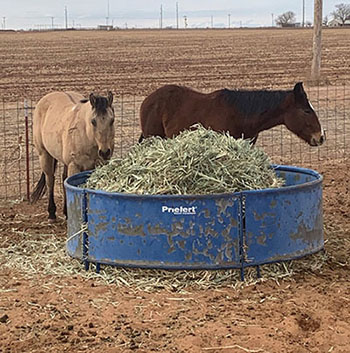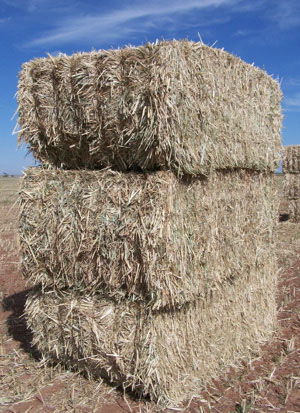Potential Poisoning of Horses Consuming Sorghum, Sudangrass, and Sorghum-sudangrass Hybrid Forages
Guide B-720
Jason L. Turner, Mark Marsalis, and Rebecca Creamer
College of Agricultural, Consumer and Environmental Sciences, New Mexico State University
Respectively, Professor and Extension Horse Specialist, Department of Extension Animal Sciences and Natural Resources; Professor and Extension Forage Specialist, Department of Extension Plant Sciences; and Professor, Department of Entomology, Plant Pathology, and Weed Science, New Mexico State University. (Print Friendly PDF)
Introduction
Many livestock owners are aware of the potential for nitrate toxicity and prussic acid (hydrogen cyanide; HCN) poisoning with animals consuming sorghum species (e.g., forage sorghum, sudangrass, and sorghum-sudangrass hybrids). Over time, research has led to the development of management, harvesting, and feeding recommendations for forages that may contain dangerous concentrations of nitrates and HCN. These recommendations are available in NMSU Extension Guide A-332, Sorghum Forage Production in New Mexico (https://pubs.nmsu.edu/_a/A332/) (Marsalis, 2011).
Although alfalfa and cool-season or warm-season grasses are the mainstays for most horse grazing and haying operations, from time to time horse owners wish to investigate other forage options for horses. Most often this occurs in times of drought when there are price increases in traditional forages used for hay for horses, or there is limited availability of those traditional forages. In these instances, one recurring question is “Can I graze or feed sorghum pasture or hay to my horses?” The purpose of this guide is to educate horse owners on the challenges and potential risks associated with feeding sorghum, sudangrass, and sorghum-sudangrass hybrid forages to horses.

Photo by Ryan Craig, Roosevelt County 4-H Agent.
Description of Plants
Sorghums (Sorghum bicolor, S. bicolor var. sudanense, S. bicolor var. drummondii) are warm-season, annual grasses (Figure 1) known for their drought and heat tolerance and high yield potential, attributes that are particularly suitable for New Mexico growing conditions. The sorghums that are predominantly used for forage or feeding purposes fall into three main categories: forage sorghums, sudangrasses, and sorghum-sudangrass hybrids. Of these, sudangrass and sorghum-sudangrass hybrids are used most often for grazing pasture and hay production due to their finer stems and leaves and regrowth potential (Figure 2). Some vernacular names commonly used in forage production are haygrazer, higear (hegari), cane (red top), sorgo, sudan, sudex, and sumac, although there are countless varieties now on the market with varying crosses of the sorghum types. Plant height can range from 6–15 feet, and plants can be harvested or grazed multiple times depending on length of growing season and planting date (Marsalis, 2011). Johnsongrass (Sorghum halepense), though sometimes used as forage for livestock, is considered a weed, and fields or hay should be examined for its presence prior to grazing or feeding to avoid ingestion of toxic compounds (Gaskill, 2010).

Figure 1. A field of irrigated forage sorghum-sudangrass hybrid growing in Alcalde, NM (photo by Mark Marsalis).

Figure 2. This young regrowth is potentially very toxic to livestock. Toxicity potential is greatly reduced by allowing regrowth of forage sorghum vegetation to reach 18–24 inches in height before grazing or harvesting (photo by Mark Marsalis).
Sorghum plants make highly nutritious pasture and hay. The nutritive value of fresh pasture and hay (cut prior to heading) can be as high as 60–70% total digestible nutrients (TDN), digestible energy (DE) greater than 1.05 Mcal/lb, and greater than 15% crude protein (CP) if fertilized properly (Marsalis et al., 2007, 2008). However, fiber content is generally higher than alfalfa and other finer grass hays grown in New Mexico. Sorghum hays cut prior to heading have nutritive values (CP, fiber, TDN) similar to wheat and triticale hay cut at boot stage. If plants are managed in a way that maintains fine stems and leaves, then palatability for horses can be good. Sorghum hay is usually baled in large round or square bales (Figures 3A and 3B), although small square bales are occasionally marketed in the region.

Figure 3A. Sudangrass harvested into net-wrapped round bales (photo by Mark Marsalis).

Figure 3B. Large square bales of sorghum-sudangrass hay stacked in the field (photo by Mark Marsalis).
Toxic Compounds
There are two primary concerns for livestock owners feeding or grazing sorghum forages. The first is nitrate toxicity where the plant accumulates high levels of nitrate. Once consumed, this nitrate is converted to nitrite by microorganisms present in the rumen of ruminant animals. Since horses are non-ruminants, this conversion does not occur until the hindgut, and there are no known reports of nitrate toxicity in horses consuming sorghum, sudangrass, or sorghum-sudangrass hybrid forages (Lewis, 1995). However, ingestion of toxic nitrite by horses can occur when nitrates in forages or water have been converted to nitrite by environmental microbes prior to consumption (Gaskill, 2009).
The second toxicity concern stems from the release of free prussic acid (hydrogen cyanide; HCN) in the plant following periods of stress. In grazing situations, the ingestion of plants containing high levels of HCN leads to cyanide poisoning. Ruminants grazing plants with high levels of HCN precursors (cyanogenic glucosides, such as dhurrin) are at greater risk of poisoning than horses. Ruminants are more susceptible than horses due to the microbial population in the rumen (which converts cyanogenic glucoside precursors to free HCN) as well as the higher, or more neutral, rumen pH compared to the acidic equine stomach. Still, horses are not immune to the effects of prussic acid. However, they have a lower risk of acute poisoning (Cope, 2014). It is commonly thought that sudangrasses, and sorghum-sudangrass hybrids, contain less dhurrin than grain or forage sorghums; however, there is no concrete data to support this claim. Water stress (i.e., drought) and application of nitrogen fertilizer have been shown to increase dhurrin levels in sorghums.
Beyond these two concerns, horses grazing these forages may develop sorghum cystitis ataxia syndrome, a poorly understood syndrome, which causes nerve damage in all types of horses and fetal birth defects in pregnant mares (Gaskill, 2010). These two conditions may appear as a result of chronic exposure to low-levels of cyanide or cyanogenic glucosides through grazing these forages for a period of weeks to months (Cope, 2014). An early report on this syndrome (Van Kampen, 1970) suggested the conversion of HCN to yield a dipeptide called γ-glutamyl-β-cyanoalanine, which may be the causative agent responsible for the sorghum cystitis ataxia syndrome in horses. This conversion of HCN to γ-glutamyl-β-cyanoalanine is at the crossroads of several metabolic pathways within the plant, and the formation, and subsequent role, of γ-glutamyl-β-cyanoalanine as a storage molecule for HCN or as an alternate metabolite of cellular processes remains under investigation (Machingura, 2016). Free HCN, cyanogenic glucosides, and β-cyanoalanine have all been suggested as causative agents of this condition in horses.
Symptoms of Poisoning in Horses
The few cases of nitrate poisoning in horses stem from high nitrate levels in contaminated groundwater, direct consumption of fertilizer, or consumption of forage grown in the area of spilled fertilizer. Early symptoms of nitrate/nitrite poisoning include colic, frequent urination, and diarrhea, followed by difficulty breathing, increased heart rate, muscle tremors, weakness and abnormal gait, seizures, blue to brown discoloration of the gums, and death (Waldridge, 2010; Thompson, 2015).
In cases of acute cyanide poisoning, the horse will generally show clinical signs within 15 minutes to a few hours, followed by death within two hours of the onset of these symptoms. Characteristic symptoms include difficulty breathing and rapid respiration, foaming at the mouth, dilated pupils, ataxia (incoordination of the limbs), muscle tremors, and convulsions (Cope, 2014; Knight, 1995).
The sorghum cystitis ataxia syndrome of horses appears to be due to chronic ingestion of cyanide (HCN or another metabolite) over a longer period, rather than the acute toxicity problems observed with feeding sorghums to ruminants (Gaskill, 2010). As the horse consumes low levels of the toxin from the forage over a period of weeks, the clinical symptoms related to the damage to the spinal cord and nerves begin to appear. The horse will gradually develop ataxia, especially in the hind end, most evident when asking the horse to back or turn. Paralysis of the bladder can lead to dribbling or leaking of urine in both males and females, with females showing signs of urine scald on the hindquarters. Inflammation of the bladder and kidneys may also develop. In pregnant mares, the toxins may also result in abortion or skeletal malformations of the developing fetus. Once the neurological symptoms appear, the nerve damage is permanent and the prognosis for the animal is poor. As the condition progresses, paralysis of the tail and hind legs may occur (Cope, 2014; Gaskill, 2010).
Another consideration that makes sorghum hays potentially harmful to horses is the way in which the hay is cured and baled. Sorghum has larger stalks and leaves than most other hays. As such, dry-down during the curing process can be difficult. Sorghums are sometimes baled too wet, which can lead to mold growth in the bale. As with all equine feedstuffs, hay containing mold should not be fed to horses because it poses health risks due to potential toxins carried in the mold, and the mold may aggravate respiratory conditions (e.g., heaves, asthma, COPD, etc.) of both horses and their owners.
Conclusion
While sorghum forages provide a good source of nutrients, there are concerns that horses may develop clinical symptoms associated with toxicity. In regard to feeding sorghum, sudangrass, and sorghum-sudangrass hybrid hay to horses, there is a mix of opinions in the available literature on whether or not this is a safe practice. Some experts report that sorghum cystitis ataxia syndrome is not observed when properly cured hay is fed to horses, but others firmly warn against feeding hay from these forages to horses. This discrepancy may stem from differences in cyanogenic glucoside content among plant varieties, impacts of pre-harvest plant stress, environmental conditions during the hay curing process, conversion of HCN to other potentially toxic compounds (such as γ-glutamyl-β-cyanoalanine), and amount of consumption by individual horses.
A renowned expert in the field of poisonous plants and livestock toxicology, Dr. Anthony Knight, DVM, gives the following advice: “Unless it is certain that the sorghum hay is from species of sorghum that have been selected to be free of cyanide, it is risky to feed the sorghum hay to horses…for extended periods” (Knight, 2020). While there is much interest in utilizing “low” or “no” dhurrin (HCN precursor) sorghum forages, these varieties are still in the developmental stages, and it may be several years before these are released commercially.
At this time, the authors do not recommend grazing horses on fields of growing sorghum plants, especially for extended periods, without testing for potential toxins. We strongly caution horse owners to consider the potential risks associated with feeding sorghum-type hays to horses. With the knowledge gained from this guide, owners can assess their own situation and make a decision based on their accepted level of risk versus benefit concerning their equines.
References:
Cope, R.B. 2014. Overview of cyanide poisoning [Online]. The Merck Veterinary Manual. Retrieved November 1, 2020, from https://www.merckvetmanual.com/toxicology/cyanide-poisoning/overview-of-cyanide-poisoning?query=prussic%20acid%20poisoning#
Gaskill, C. 2009, October. Nitrate poisoning in horses [Online]. Equine Disease Quarterly, 18(4). Retrieved November 1, 2020, from https://gluck.ca.uky.edu/sites/gluck.ca.uky.edu/files/q_oct09.pdf
Gaskill, C. 2010, November. Johnsongrass poisoning in horses [Online]. Bluegrass Equine Digest. Retrieved November 1, 2020, from https://gluck.ca.uky.edu/sites/gluck.ca.uky.edu/files/18_bed-nov2010_0.pdf
Knight, A.P. 1995. Plant poisoning of horses. In L.D. Lewis, Equine clinical nutrition: Feeding and care (pp. 484–486). Philadelphia: Williams and Wilkins.
Knight, A.P. 2020. Guide to poisonous plants [Online]. Retrieved November 1, 2020, from https://csuvth.colostate.edu/poisonous_plants/Plants/Details/30
Lewis, L.D. 1995. Feed-related poisonings of horses. In L.D. Lewis, Equine clinical nutrition: Feeding and care(pp. 532–533). Philadelphia: Williams and Wilkins.
Machingura, M., E. Salomon, J.M. Jez, and S.D. Ebbs. 2016. The β-cyanoalanine synthase pathway: Beyond cyanide detoxification. Plant, Cell & Environment, 39, 2329–2341. doi: 10.1111/pce.12755
Marsalis, M.A. 2011. Sorghum forage production in New Mexico [Guide A-332]. Las Cruces: New Mexico State University Cooperative Extension Service.
Marsalis, M.A., R.E. Kirksey, R. Flynn, M.K. O’Neill, L.M. Lauriault, and M. Place. 2007. New Mexico 2006 corn and sorghum performance tests. Las Cruces: New Mexico State University Agricultural Experiment Station.
Marsalis, M.A., R.E. Kirksey, L. Carrasco, R. Flynn, M.K. O’Neill, L.M. Lauriault, and M. Place. 2008. New Mexico 2007 corn and sorghum performance tests. Las Cruces: New Mexico State University Agricultural Experiment Station.
Thompson, L.J. 2015. Overview of nitrate and nitrite poisoning [Online]. The Merck Veterinary Manual. Retrieved November 1, 2020, from https://www.merckvetmanual.com/toxicology/nitrate-and-nitrite-poisoning/overview-of-nitrate-and-nitrite-poisoning?query=nitrate%20poisoning
Van Kampen, K.R. 1970. Sudan grass and sorghum poisoning of horses: A possible lathyrogenic disease. Journal of the American Veterinary Medical Association, 156, 629–630.
Waldridge, B. 2010, January 21. Nitrate and nitrite toxicity in horses [Online]. Equinews. Retrieved November 1, 2020, from https://ker.com/equinews/nitrate-nitrite-toxicity-horses/
For Further Reading
A-332: Sorghum Forage Production in New Mexico
pubs.nmsu.edu/_a/A332/
B-711: Help Your Horse Handle Heat Stress
pubs.nmsu.edu//_b/B711/
CR-695: Forage Selection and Establishment for Irrigated Pastures and Hay in New Mexico
pubs.nmsu.edu//_circulars/CR695/

Jason L. Turner is a Professor and Extension Horse Specialist at NMSU. He was active in 4-H and FFA while growing up in Northeastern Oklahoma. His M.S. and Ph.D. studies concentrated on equine reproduction, health, and management. His Extension programs focus on proper care and management of the horse for youth and adults.
To find more resources for your business, home, or family, visit the College of Agricultural, Consumer and Environmental Sciences on the World Wide Web at pubs.nmsu.edu/.
Contents of publications may be freely reproduced, with an appropriate citation, for educational purposes. All other rights reserved. For permission to use publications for other purposes, contact pubs@nmsu.edu or the authors listed on the publication.
New Mexico State University is an equal opportunity/affirmative action employer and educator. NMSU and the U.S. Department of Agriculture cooperating.
March 2021 Las Cruces, NM


